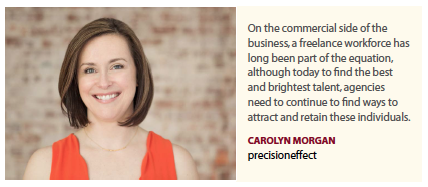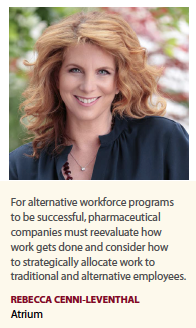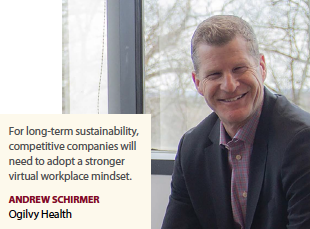The rise of the gig economy is empowering workers to maximize their freedom and choose journeys over jobs. According to Morgan Stanley, within 10 years, freelance workers may represent more than 50% of the U.S. working population — leaving big questions as to what are the implications for corporations and corporate cultures.
Shifting demographics, digitalization, and the desire for greater job satisfaction could redesign the landscape of global employment into a freelance-driven model in the  coming years, presenting benefits and challenges to corporations, the staffing industry, and the freelancers themselves. In the United States, the freelance workforce has grown three times faster than the overall workforce.
coming years, presenting benefits and challenges to corporations, the staffing industry, and the freelancers themselves. In the United States, the freelance workforce has grown three times faster than the overall workforce.
Within the IT sector, C-suite executives recognize the future of work has arrived: 83% say by 2050 the economy will shift toward gig-based work over full-time employees (FTEs), according to a report from Appirio. With technology considered to be one of the biggest drivers of connectivity, innovation, and products and services within the life sciences, this movement toward a gig economy is also impacting how pharma, biotech, biopharma, and service-based companies will need to evaluate and resource their workforces in the future.
Enterprise leadership acknowledges that offering the kind of flexibility these workers demand is even more important than compensation when attracting top talent — and workers agree. According to Appirio, 81% of IT staffers say they’re more likely to leave a job because of a lack of flexibility in working hours and location than for reasons of compensation. The tactics of HR departments and the C-suite are using to fight the talent gap — upping the ante with compensation packages — fail to address what IT talent say they’re looking for: ownership of their job via a flexible, individualized model of what work means. The influence of this workforce cadre will have a ripple effect all the way up to the C-suite. The organization Career Addict is predicting that in the not so distance future new C-suite titles will include chief human resources officer, chief ecosystem officer, and chief freelance relationship officer. The latter position is an unusual C-level position, but it’s going to be essential in the years to come. Since freelancing is becoming more popular, soon there are going to be more freelancers than employees working within businesses. This means that companies working with these professionals will need to appoint a professional who can maintain and grow the company’s partnership and reputation in the freelance community.
Forbes estimates that by 2020 half of the U.S. workforce will be freelancers. There are a number of reasons contributing to this trend, including changing attitudes toward work; employers are increasingly using gig workers to lower costs and meet project needs; and technology and infrastructure are growing to accommodate freelancers.
Preparing for a Gig Workforce
As the major uptick in the gig workforce continues, it’s important that pharmaceutical companies take the necessary steps now to effectively leverage this type of worker.
“There are proactive steps employers can take to be ready to take advantage of the value this unique segment of workers can bring," says Rebecca Cenni-Leventhal, CEO and  founder, Atrium. “The first step is to perform a skills gap analysis to pinpoint what employee skills are needed to meet current and future business goals and up-skill current employees. Making investments into current employees is not only good for retention, it also helps to keep your team competitive. Knowing what employees can — and can’t — do enables employers to target the right type of gig workers when needs arise. Finally, it’s crucial to look forward, perform workforce planning, and take steps to attract talent. It remains vital to proactively create and nurture a talent pool that continuously support forecasted hiring needs."
founder, Atrium. “The first step is to perform a skills gap analysis to pinpoint what employee skills are needed to meet current and future business goals and up-skill current employees. Making investments into current employees is not only good for retention, it also helps to keep your team competitive. Knowing what employees can — and can’t — do enables employers to target the right type of gig workers when needs arise. Finally, it’s crucial to look forward, perform workforce planning, and take steps to attract talent. It remains vital to proactively create and nurture a talent pool that continuously support forecasted hiring needs."
Many life-sciences companies are already incorporating gig workers into the workforce and have for some time. However, Tamara Dillon, senior VP of human resources, Akebia Therapeutics, says companies can do a better job of stepping back and evaluating how all of the pieces can fit together to ensure a “win" for all parties: the companies, the alternative workers, and the full-time employees (FTEs).
“My advice: speak with gig workers in parallel with FTEs to understand how each perceives the other and to determine the best mix for integrating the two," she says. “Be flexible as business needs can change rapidly, as can workforce dynamics. And don’t underestimate the importance of having the right technology in place — you’ll rely on it for seamless communication across your organization."
There are clearly benefits to both the organization and worker of a gig economy. “From an organizational standpoint, the biggest benefit is a reduction in operational expense from the standpoint that the company does not have as many workers full-time, on staff, collecting pay and benefits," says Terry Herring, managing director, 3 Seasons Capital. “From a worker’s standpoint, there is tremendous flexibility in working on his or her own schedule and from his or her own location."
There are other added values to be realized in uncovering fresh and unconventional  perspectives, building business relationships with a vast and diverse collection of people, and more, Mr. Herring says, noting that there are pitfalls to this model as well.
perspectives, building business relationships with a vast and diverse collection of people, and more, Mr. Herring says, noting that there are pitfalls to this model as well.
“From the corporate side, especially in the pharmaceutical industry, there are security and intellectual property concerns with having people not directly tied to the organization working within the walls of the company and, at times, serving as the voice of the organization," he explains. “Properly vetting a crowdworker workforce will take time and cost money. From the worker’s standpoint, many will quickly learn that there are no guarantees in gig work, and a person is only as good as his or her most recent project."
A Gig Workforce: A Boon or a Bust?
One of the many challenges facing pharmaceutical employers today centers around how to identify and retain the best talent in the marketplace — to say competition is fierce is an understatement. “In the long run, an alternative workforce will be a benefit for both the pharma industry and the worker," Ms. Cenni-Leventhal says. “However, for alternative workforce programs to be successful, pharmaceutical companies must reevaluate how work gets done and consider how to strategically allocate work to traditional and alternative employees."
Experts say the key is engaging a workforce that is flexible enough to keep pace with evolving needs that can hit the ground running; that’s where contingent labor comes in.
“Gig workers are seeking interesting projects where they feel they can make valuable contributions and companies can benefit from the short-term expertise without a long-term commitment — that often comes without the financial burden of a hefty benefits package — to quickly and economically get results," Ms. Cenni-Leventhal says.
Many companies view a flexible workforce to be a boon for many of the reasons already articulated — flexibility and cost — as well as a way to attract talent in new ways.
“A gig workforce is a boon for the industry because it brings great talent in the door in a way that could not have been done years ago — and specifically talent that has a broader purview from working across so many companies," Ms. Dillion says. “For smaller businesses that don’t have headcount, alternative workers are particularly helpful as a means to timely access to needed expertise." A gig model is also a boon for those individuals who are “single shingle" — they get to do what they love on their own flexible terms. “And it’s a boon for the FTEs, who get to work alongside experts and learn best practices from them — assuming that the culture is one of learning and collaboration," she continues. “This said, if alternative workers are used in place of FTEs, companies run the risk of eroding their culture. The key is to look at the mix from the bigger picture so that you can realize these synergies and make it positive for everyone."
Over the past decade, there have been major shifts throughout the life-sciences industry in how, when, and where people work. More people than ever are working remotely, sharing offices, and in some cases jobs, moving from project to project, telecommuting,  and participating in the modern economy as a just-in-time resource hired on an as needed basis. Andrew Schirmer, CEO, Ogilvy Health, says companies have been accelerating this shift for effectiveness and efficiency reasons.
and participating in the modern economy as a just-in-time resource hired on an as needed basis. Andrew Schirmer, CEO, Ogilvy Health, says companies have been accelerating this shift for effectiveness and efficiency reasons.
“As financial performance pressures continue to mount across the healthcare space, employers have been seeking ways to better manage staff power as well as capital expenditures," he says. “Many of the leading bioscience companies are already well into this transformation with significant numbers of employees working remotely. Others are creating an open office space where there are no assigned desks or workstations — you simply select a seat when you show up and get to work. And manufacturers and healthcare ad agencies have been using freelance, flex, or consultant employees as a way to manage costs and productivity for years."
Experts at Kelly OCG note that the heightened demand for higher-level and more complex skills, coupled with intense competition from tech companies, is causing life-sciences companies to take a more open and fluid approach to talent, with greater utilization of external and independent workers and partners.
On the commercial side of the business, a freelance workforce has long been part of the equation, although today to find the best and brightest talent, agencies need to continue to find ways to attract and retain these individuals, says Carolyn Morgan, president, precisioneffect.
“This includes things like flexible hours, unlimited vacation times, and loan assistance programs. But what really matters is being a mission-driven organization of colleagues who challenge each other while learning, growing and making a real difference." There are positives and negatives for both the agency and the freelancer. On the positive, for freelancers, they have flexibility; they can take on cool, out-of-the-box assignments; they can be the masters of their own destiny, and many thrive in this world, Ms. Morgan says.
Though many companies still rely heavily on the perceived — and often, very real —  sense of collaboration and team ethos that inevitably comes when people work closely together in physical proximity, companies, including agencies need to find different ways to connect their employees, Mr. Schirmer says.
sense of collaboration and team ethos that inevitably comes when people work closely together in physical proximity, companies, including agencies need to find different ways to connect their employees, Mr. Schirmer says.
“For long-term sustainability, competitive companies will need to adopt a stronger virtual workplace mindset," he says. “One where individuals have the potential to be connected 24/7 but don’t have to be constantly sitting next to a co-worker to be productive. Technology will allow for seamless connectivity to recreate live meetings, workshops, and hackathons wherever possible."
Mr. Schirmer says in general, companies and employees alike will need to embrace a new era of fluidity where part-time, freelance, and contract employees may well outnumber full-time staff. The increasing challenge will be to maintain the team energy, dynamic, and continuity created by consistent, human interaction in a world where more of us are being connected to each other through a screen and an earpiece. And employees will need to get more comfortable with an increasingly transient and transactional relationship with their employer(s) where they can act with the flexibility of a free agent while still showing loyalty to the company that is paying them — on that given day.(PV)
~~~~~~~~~~~~~~~~~~~~~~~~~
Pharmacies and a Good Gig
 Valerie Metzker
Valerie Metzker
Head of Business
Development,
Roadie
Like other areas of the vastly evolving life-sciences and healthcare industries, pharmacies are taking advantage of on-demand needs of its customers.
There’s no doubt that adopting a gig economy workforce might be a large shift for some pharmacies, says Valerie Metzker, head of business development at Roadie, but what they stand to gain far outweighs any obstacles to set it up. Outsourcing tasks to a crowdsourced workforce frees up time for employees to focus on building customer relationships and increasing sales. More than that, traditional solutions — particularly in the delivery space — lack the flexibility and scalability needed to meet growing consumer demand for next- and same-day service. Nothing highlights this more than CVS, Walgreens, and Amazon investing in an alternative delivery workforce to handle their ever-increasing volume.


















